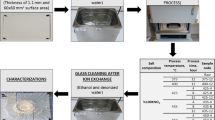Abstract
In this work, we have submitted a soda lime glass to thermochemical treatment by ion exchange in order to introduce compressive stresses in their surface. Subsequently, we studied the hot-cold thermal shock resistance of ion-exchange reinforced glass. A potassium ion from the molten salt bath replaces the sodium ion of the glass surface by a superficial diffusion process. We have determined the potassium diffusion profile by two techniques: X-ray fluorescence spectroscopy XRF and X-rays microanalysis coupled with Scattering Electronic Microscopy. In addition, for the same purpose, we used X-ray fluorescence spectroscopy. Then, we determined by micro-indentation the profile of the compressive stresses induced in the glass surface by the exchange of Na+ ions by larger ones of K+. The compressive stress profile induced by chemical tempering depends on potassium ion concentration. It reaches a maximum value of 988 MPa for a treatment done during 50 hours at 480°C. We have subjected the glass specimens treated by ion exchange to a hot-cold thermal shock technique; we realized the cooling by air jet at room temperature. The heat transfer coefficient was about 600 W/m2 °C (Biot number β = 0.3). We have determined the residual strengths of the ion exchange treated and thermal shocked specimens by a three-point bending test. The strength is improved; it passes from 90 MPa of the as received glass to 380 MPa for the chemically treated glass. We noticed that the critical temperature difference ΔTc, which caused the thermal shock fracture, depends on the glass samples states. Consequently, because of the thermochemical treatment, ΔTc has shifted to higher temperatures. Its value was 254°C for raw glass and reached 455°C for the case of reinforced glass by ion exchange at 480°C during 50 hours. The thermochemical ion exchange treatment improve the glass thermal shock resistance.












Similar content being viewed by others
REFERENCES
Es’kin, S.V., Kosobudsky, I.D., Zhimalov, A.B., Ushakov, N.M., and Gribov, A.N., Strengthening coating based on silica nanoparticles for soda-lime-silica glass, Inorg. Mater., 2014, vol. 50, pp. 63–67.
Malou, Z., Hamidouche, M., Bouaouadja, N., and Fantozzi, G., Statistical analysis of a soda lime glass thermal shock resistance, Ceram.—Silikaty, 2011, vol. 55, no. 3, pp. 215–221.
Peitl, O. and Zanotto, E., Thermal shock properties of chemically toughened borosilicate glass, J. Non-Cryst. Solids, 1999, vol. 247, pp. 39–49.
Bousbaa, C., Madjoubi, M.A., Hamidouche, M., and Bouaouadja, N., Effect of annealing and chemical strengthening on soda lime glass erosion wear by sand blasting, J. Eur. Ceram. Soc., 2003, vol. 23, pp. 331–343.
Sglavo, V., Quaranta, A., Allodi, V., and Mariotto, G., Analysis of the surface structure of soda lime silicate glass after chemical strengthening in different KNO3 salt baths, J. Non-Cryst. Solids, 2014, vol. 401, p. 105–109.
Donald, I.W., Methods for improving the mechanical properties of oxide glasses, J. Mater. Sci., 1989, vol. 24, pp. 4177–4208.
Sinton, C.W., Lacourse, W., and O’Connell, M.J., Variations in K+–Na+ ion exchange depth in commercial and experimental float glass compositions, Mater. Res. Bull., 1999, vol. 34, pp. 2351–2359.
Varshneya, A.K., Chemical strengthening of glass: Lessons learned and yet to be learned, Int. J. Appl. Glass Sci., 2010, vol. 1, pp. 131–142.
Gy, R., Ion exchange for glass strengthening, Mater. Sci. Eng., 2008, vol. 149, pp. 159–165.
Kingery, W.D., Factor affecting thermal stress resistance of ceramic materials, J.Am. Ceram. Soc., 1955, vol. 38, pp. 3–15.
Hasselman, D.P.H. and Fulrath, R.M., Proposed fracture theory of a dispersion-strengthened glass matrix, J. Am. Ceram. Soc., 1966, vol. 49, pp. 68–72.
Evans, A.G., Thermal shock fracture in ceramic materials, Proc. Br. Ceram. Soc., 1975, vol. 25, pp. 217–35.
Schneider, G.A., Thermal shock criteria for ceramics, Ceram. Int., 1991, vol. 17, pp. 325–33.
Malou, Z., Hamidouche, M., Bouaouadja, N., Chevalier, J., and Fantozzi, G., Thermal shock resistance of a soda lime glass, Ceram.–Silikaty, 2013, vol. 57, no. 1, pp. 39–44.
Hamidouche, M., Louahdi, R., Bouaouadja, N., and Osmani, H., The fracture of soda lime glass, Glass Tech., 1994, vol. 35, no. 4, pp. 183–185.
Lawn, B.R. and Swain, M.V., Microfracture beneath point indentations in brittle solids, J. Mater. Sci., 1975, vol. 10, p. 113.
Pharr, G.M., Measurement of mechanical properties by ultra-load indentation, Mater. Sci. Eng. A, 1998, vol. 253, nos. 1–2, p. 151.
Marshall, D.B. and Lawn, B.R., An indentation technique for measuring stresses in tempered glass surfaces, J. Am. Ceram. Soc., 1977, vol. 60, nos. 1–2, pp. 86–87.
Anstis, G.R., Chantikul, P., Lawn, B.R., and Marshall, D.B., A critical evaluation of indentation techniques for measuring fracture toughness: I. Direct crack measurements, J. Am. Ceram. Soc., 1981, vol. 64, no. 9, 533–538.
Wu, X.R., Application of weight function method for crack analysis in thermal stress field, in Proceedings of the Conference on Thermal Shock and Thermal Fatigue Behavior of Advanced Ceramics, November 8–13, 1992, Munich, Germany, Shneider, G.A., Ed., Germany: Academic, 1993.
Talimian, A., Mariotto, G., and Sglavo, V.M., Electric field-assisted ion exchange strengthening of borosilicate and soda lime silicate glass, Int. J. Appl. Glass Sci., 2017, vol. 8, no. 3, pp. 1–10.
Author information
Authors and Affiliations
Corresponding author
Ethics declarations
ACKNOWLEDGMENTS
The authors thank Madam Sandrine Cottrino for her precious help. The General Directorate of Scientific Research and Technological Development (GDSRTD) for its financial support.
CONFLICT OF INTEREST
The authors declare to have no conflict of interest.
Rights and permissions
About this article
Cite this article
Bennouioua, T., Malou (Hamidouche), Z., Hamidouche, M. et al. Thermal Shock Behavior of a Soda Lime Glass Treated by Ion Exchange. Glass Phys Chem 46, 462–473 (2020). https://doi.org/10.1134/S1087659620060048
Received:
Revised:
Accepted:
Published:
Issue Date:
DOI: https://doi.org/10.1134/S1087659620060048




